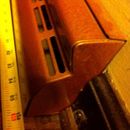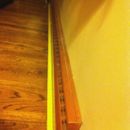What’s up with diffusers?
I haven’t found much info on this site regarding diffusers. I don’t know the difference between a good one and a bad one. Here’s a photo typical of the ones at my grandma’s house, probably original, ca 1948. This one is the longest, 8 ft. They all have the same profile, 5in at the back, 3 in at the base. The duct opening is in the center an is 2″x12″. I’m guessing these are no good, right?
GBA Detail Library
A collection of one thousand construction details organized by climate and house part











Replies
David,
Are those covers to hydronic finned-tube baseboard units? Or diffusers for a forced-air distribution system?
Forced air - converted from oil to gas some time ago, though that may be extraneous info.
David,
If you are designing a new forced-air system for an energy-efficient house -- especially one with diffusers located near the ceiling, at the center of the house, rather than at the floor near the perimeter of the house -- the diffusers have to be carefully chosen so they have adequate "throw."
These issues don't really apply to an older house. Almost any type of floor register can work to distribute heat into a room, as long as (a) the duct system is tight, with sealed seams, and (b) the air flow through the register meets the specs required by your duct system design.
So, is air flow adequate? Are the duct seams sealed? Address these issues first, and don't worry about the type of register.
Many thanks for that, Martin.
I'm working on rebuilding the ducts in the crawlspace, which were severely rusted out. Part of the rectangular section was installed in a way that left it resting on the dirt floor. So I'm replacing all that. I chose to use the same size, 8"x14", because I don't really understand how to do the airflow calculations. I'm reusing the 6" round branches, which seemed to be in good shape, though very loosely connected. I'm making sure the connections are fairly well sealed, but I'm not going nuts with that because I'm sealing and insulating the rim joist and crawlspace walls, and closing up the vents -- best practice as I've read on here and on buildingscience.com.
I thought the register style might be relevant, but couldn't find much information from the sources I trust. I'm glad it's nothing to worry about.
Thanks again.
David,
If you're going to the trouble of replacing your ductwork, it would have been worth doing some simple calculations to make sure that the ducts are adequately sized. Just because your house happened to have an 8x14 duct doesn't mean that it is adequate.
Sizing ducts is a big topic. But even just making a stab at performing a few duct sizing calculations is better than guessing. Here are two resources to get you started:
Three Steps to Duct Sizing
Field Duct Sizing Chart
I would bet those diffusers are pretty bad for air flow. I don't know much about it, but I believe that ACCA's Manual T addresses diffuser selection. I'd second Martin's recommendation for proper duct sizing, ideally by running a Manual D. A cheap anemometer could give you some idea of the airflow restriction by testing with the diffuser both on and off.
Many thanks for that advice.
I wanted to and would have done the the calculations if I understood how. I've read your Manual J articles, Martin, and got a fairly good handle on that. But I couldn't find trustworthy guidance on Manual D. I could have called called a professional, but they're the ones who installed this system in the first place, with the sections that rusted out and weren't even connected in the first place. So I don't trust them. You see their trucks all around town - major contractor here in Indy. Additionally, as the great philosopher Ray Davies put it so eloquently:
Circumstance has forced my hand
To be a cut price person in a low budget land
...
I'm on a low budget
The attached photo is the rectangular section on the ground after I pulled it out. The part that's pointing up was installed so as to be laying on the dirt floor of the crawlspace. As you can see, there is a large section that's rusted away.
Thanks again for pointing me in the right direction.
Obviously, the rectangular duct rusted out because of water in the crawlspace, but I'm not exactly sure where it came from. I don't think there are gutter/drainage issues. There may have been more than one problem. I know that the copper discharge tube from the water softener, which was resting on the galvanized duct, corroded to the point of having a hole through it. My guess on another source is that the discharge tube from the condensate pump, which was run to the yard through a hole in the rim joist, froze in the winter. When it did, the condensate pump's reservoir backed up and overflowed. Should I connect the condensate drain to the normal drain system and chuck the pump? That's my plan. I know it needs a trap.
I appreciate all the tips.